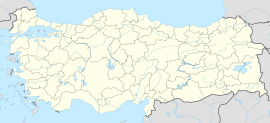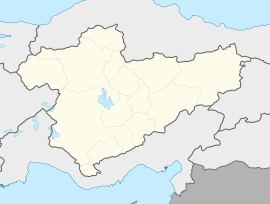Seyitgazi is a municipality and district of Eskişehir Province, Turkey.[2] Its area is 1,578 km2,[3] and its population is 12,587 (2022).[1] The central town of Seyitgazi lies at a distance of 43 km (27 mi) towards the south from the province capital of Eskişehir. The town was known formerly as Nakoleia.
Seyitgazi | |
|---|---|
District and municipality | |
 | |
 Map showing Seyitgazi District in Eskişehir Province | |
| Coordinates: 39°26′44″N 30°41′38″E / 39.44556°N 30.69389°E | |
| Country | Turkey |
| Province | Eskişehir |
| Government | |
| • Mayor | Uğur Tepe (CHP) |
Area | 1,578 km2 (609 sq mi) |
| Elevation | 990 m (3,250 ft) |
| Population (2022)[1] | 12,587 |
| • Density | 8.0/km2 (21/sq mi) |
| Time zone | UTC+3 (TRT) |
| Postal code | 26950 |
| Area code | 0222 |
| Website | www |
History
editThe town occupies the site of the Byzantine city of Nakoleia which is attested from Roman times.
After the town was conquered by the Seljuk Turks, it was known as Kala'-i-Mashihya, the Christian Castle.[4] During that time the old monastic centre dedicated to the archangel Michael was converted into a shrine to the 8th-century Muslim saint (seyyid) and warrior Battal Gazi, who allegedly fell in a battle nearby in 740.[5] The town was eventually renamed after Battal Gazi.
From 1867 until 1922, Seyitgazi was part of Hüdavendigâr vilayet.
Places of interest
editA complex (Turkish: külliye) dedicated to Battal Gazi and containing his tomb, a mosque, a medrese, cells and ceremonial rooms for dervishes as well as charitable services for the community such as kitchens and a bakery were built in 1208 on a hill overlooking the town by Ümmühan Hatun, wife of the Seljuk sultan Gıyaseddin Keyhüsrev I and further extended in 1511 by the Ottoman sultan Bayezid II. The shrine and the adjoining complex remain popular with local as well as foreign visitors.
Archaeological discoveries
editIn August 2019, researchers headed by Prof. Murat Türkteki announced the discovery of two skeletons dating back about 5,000 years in the same sarcophagus in Early Bronze Age settlement Küllüoba. Excavators assumed that one of the skeletons was a 13-year-old girl and other was a man in his late 30s.[6][7][8]
In August 2020, archaeologists headed by Prof. Murat Türktaki revealed a 5,000-year-old paint palette made of stone in the Seyitgazi district at the Küllüoba site. According to Türktaki, this palette was used for painting dishes.[9][10]
In March 2021, construction workers found a marble sarcophagus which is 1.5 meters long and 33 centimetres wide in the Seyitgazi district at the Küllüoba site.[11][12][13]
Composition
editThere are 51 neighbourhoods in Seyitgazi District:[14]
- Akin
- Aksaklı
- Aşağısöğüt
- Aslanbeyli
- Ayvalı
- Bardakçı
- Beşsaray
- Beykışla
- Büyükdere
- Büyükyayla
- Çatören
- Cevizli
- Çukurağıl
- Çukurca
- Çürüttüm
- Değişören
- Derebenek
- Doğançayır
- Fethiye
- Gemiç
- Göcenoluk
- Gökbahçe
- Gökçegüney
- Göknebi
- Gümüşbel
- İdrisyayla
- İkiçeşme
- İkizoluk
- Karacalık
- Karaören
- Kesenler
- Kırka
- Kümbet
- Numanoluk
- Örencik
- Oynaş
- Salihler
- Sancar
- Sandıközü
- Sarayören
- Sarıcailyas
- Şükranlı
- Taşlıkköy
- Üçsaray
- Yapıldak
- Yarbasan
- Yazıdere
- Yenikent
- Yeşiltepe
- Yukarısöğüt
- Yunus
References
edit- ^ a b "Address-based population registration system (ADNKS) results dated 31 December 2022, Favorite Reports" (XLS). TÜİK. Retrieved 12 July 2023.
- ^ Büyükşehir İlçe Belediyesi, Turkey Civil Administration Departments Inventory. Retrieved 12 July 2023.
- ^ "İl ve İlçe Yüz ölçümleri". General Directorate of Mapping. Retrieved 12 July 2023.
- ^ Brown, John P. (May 2013). The Darvishes Or Oriental Spiritualism. Taylor & Francis. ISBN 9781135029890. Retrieved 24 September 2023.
- ^ A.C.S. Peacock (March 2017). "Islamisation in Medieval Anatolia". Islamisation. Edinburgh University Press. ISBN 9781474417143. Retrieved 24 September 2023.
- ^ sabah, daily (2019-08-04). "5,000-year-old human skeletons unearthed in central Turkey". Daily Sabah. Retrieved 2021-03-03.
- ^ "5,000-year-old double burial unearthed in central Turkey". The Archaeology News Network. Retrieved 2021-03-03.
- ^ "5,000-year-old human skeletons unearthed in central Turkey". anews. Retrieved 2021-03-03.
- ^ SABAH, DAILY (2020-08-26). "5,000-year-old paint palette unearthed in northwest Turkey". Daily Sabah. Retrieved 2021-03-03.
- ^ "5,000-year-old paint palette unearthed in northwest Turkey". The Archaeology News Network. Retrieved 2021-03-03.
- ^ AA, DAILY SABAH WITH (2021-03-01). "Construction workers discover ancient sarcophagus in NW Turkey". Daily Sabah. Retrieved 2021-03-03.
- ^ "Строители нашли загадочный древний саркофаг в Турции". www.mk.ru (in Russian). Retrieved 2021-03-03.
- ^ "Builders find mysterious ancient sarcophagus in Turkey - Around World journal". Retrieved 2021-03-03.[permanent dead link]
- ^ Mahalle, Turkey Civil Administration Departments Inventory. Retrieved 12 July 2023.
External links
edit- District governor's official website (in Turkish)
- District municipality's official website (in Turkish)
- Map of Seyitgazi district
- Many pictures of the Battal Gazi complex and Seyitgazi village
- Governorship of Eskişehir, Turkey. "General information on Seyitgazi, Eskişehir" (in Turkish). Archived from the original on 2006-07-07.
- Governorship of Eskişehir, Directorate of Provincial Environment and Forestry (2006). "Environmental Status Report for Eskişehir Province" (PDF) (in Turkish). Archived from the original (PDF) on 2009-03-05.

